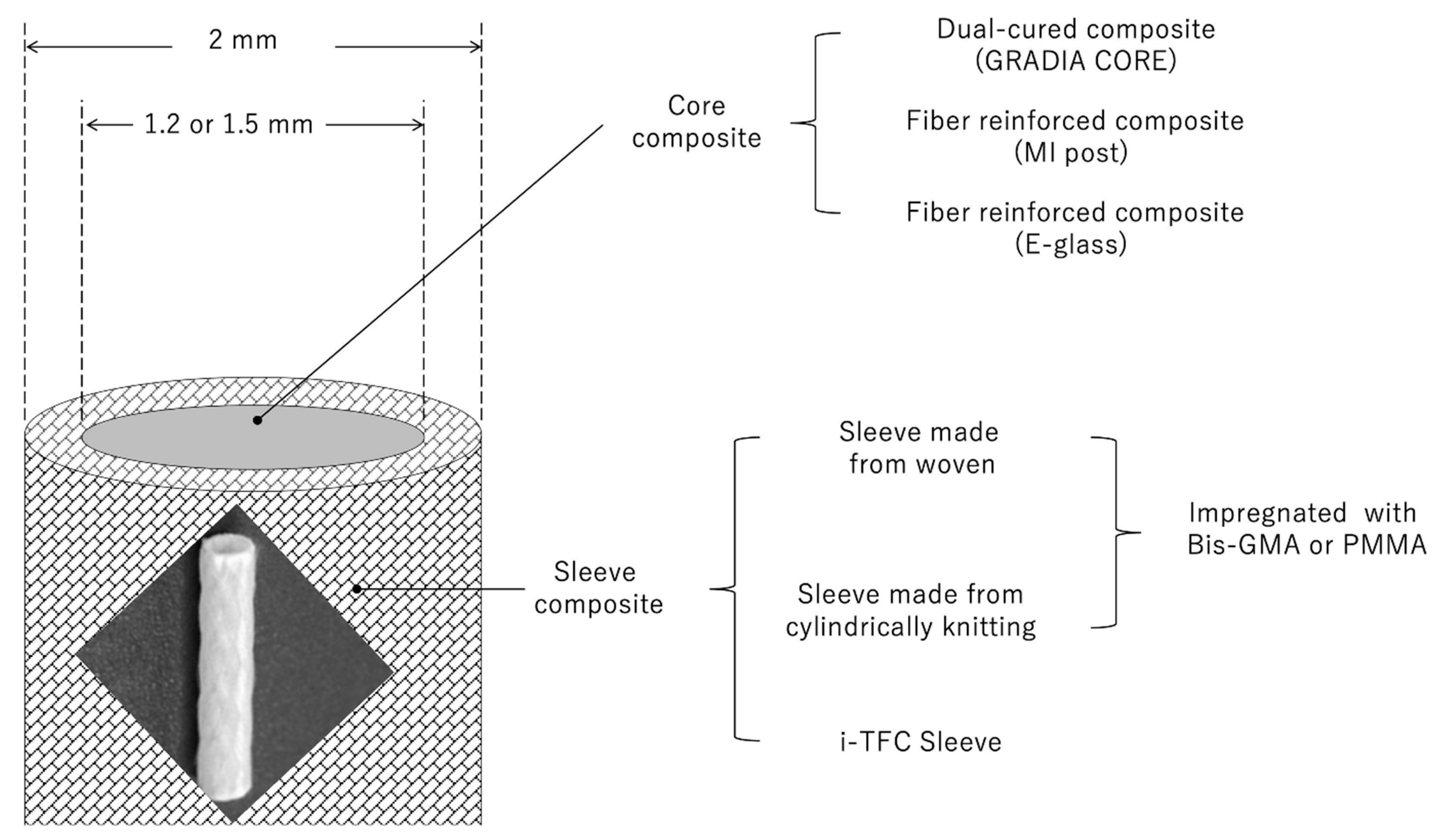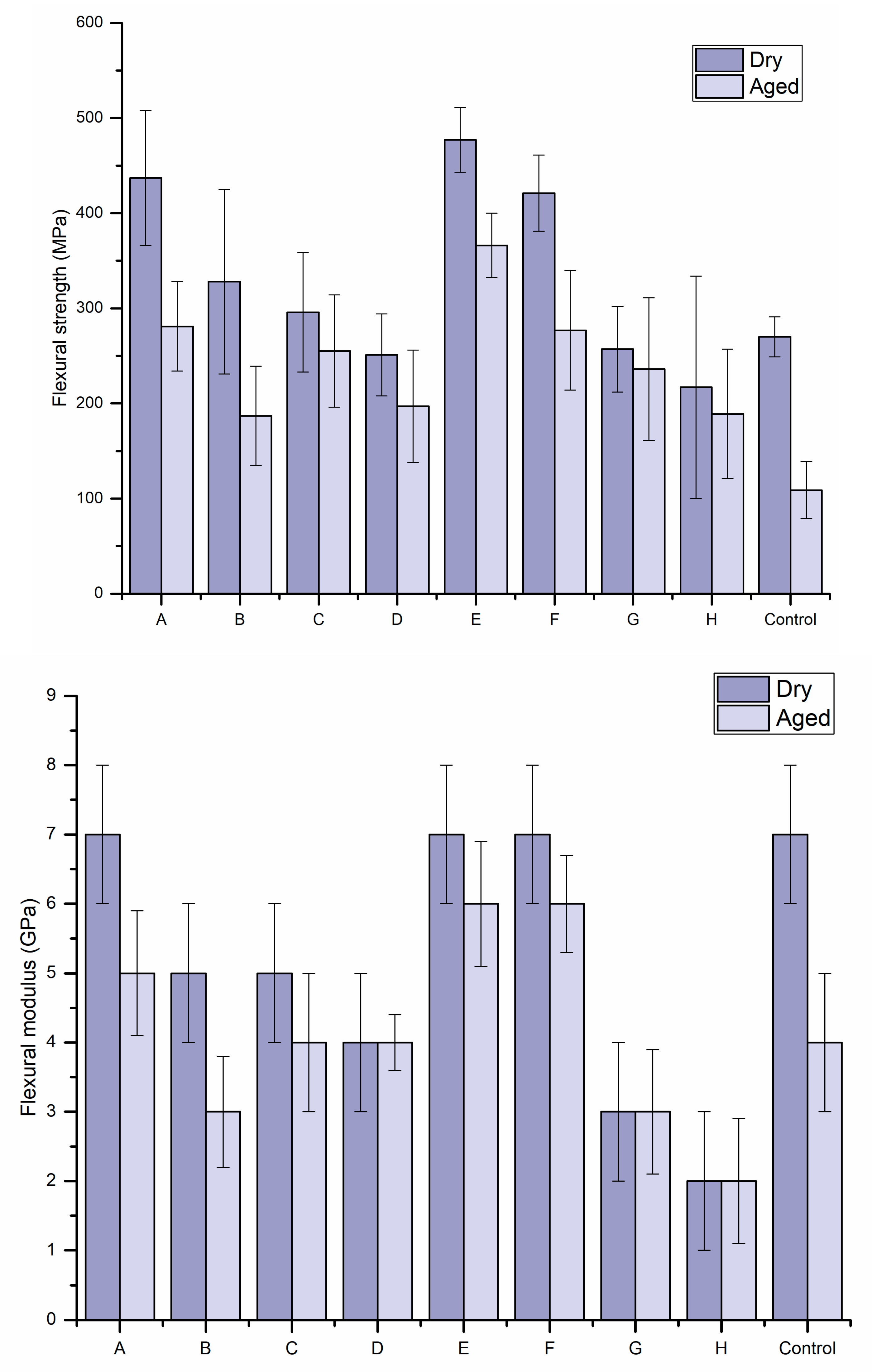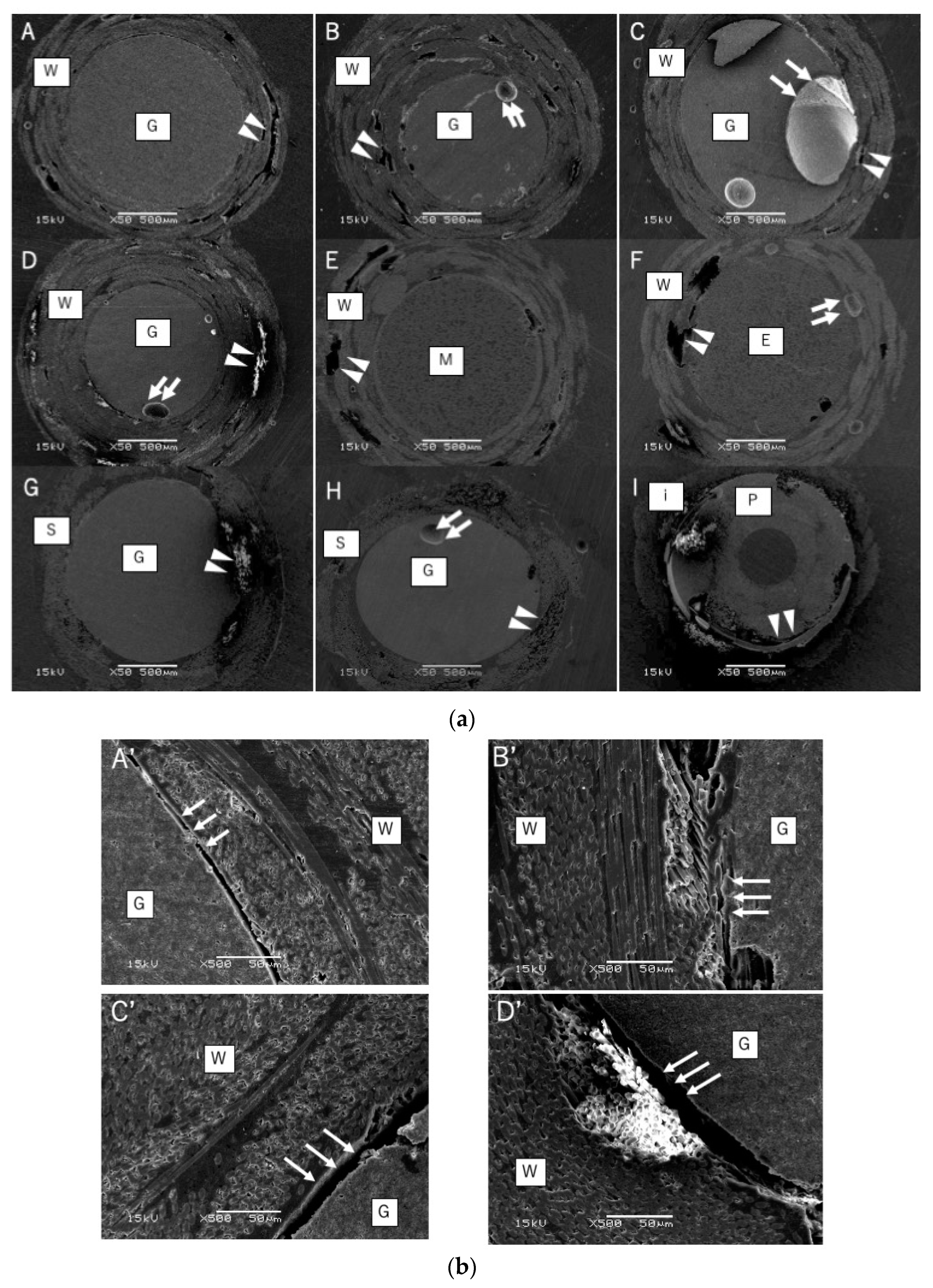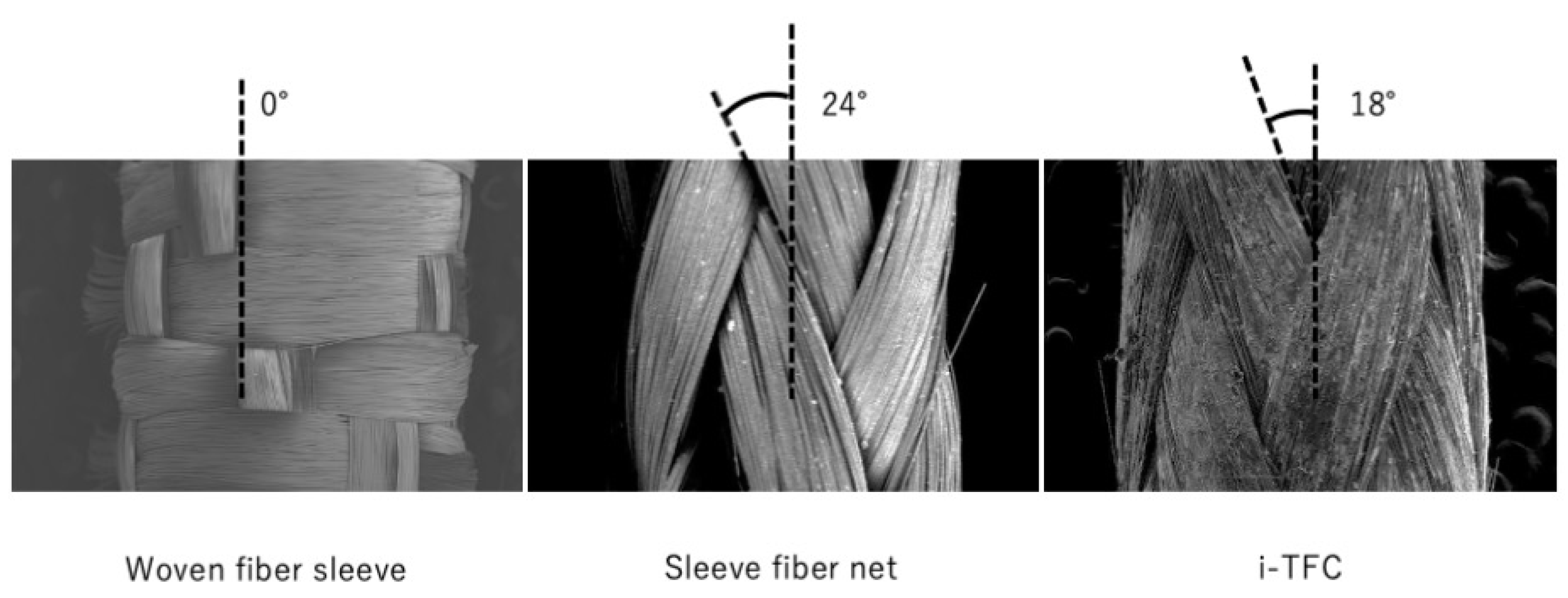Evaluation of New Hollow Sleeve Composites for Direct Post-Core Construction
Abstract
1. Introduction
2. Materials and Methods
2.1. Preparation of HSC System
2.2. Flexural Strength and Modulus of Elasticity
2.3. Microscopic Analysis
2.4. Statistical Analysis
3. Results and Discussion
4. Conclusions
- Sleeve impregnated with Bis-GMA resin mechanically performed better than those impregnated with PMMA;
- The flexural strength of the HSC system depends on the type of inner material;
- The mechanical properties of the HSC system can be modified by changing the inner diameter of the sleeve composite;
- Hydrothermal accelerated aging decreased the flexural properties compared to the control condition for the majority of the tested HSC groups; and
- Fiber orientation has an essential effect on the mechanical performance of the HSC system.
Author Contributions
Funding
Institutional Review Board Statement
Informed Consent Statement
Data Availability Statement
Conflicts of Interest
References
- Garoushi, S.; Tanner, J.; Keulemans, F.; Le Bell-Rönnlöf, A.-M.; Lassila, L.; Vallittu, P.K. Fiber Reinforcement of Endodontically Treated Teeth: What Options Do We Have? Literature Review. Eur. J. Prosthodent. Restor. Dent. 2020, 28, 54–63. [Google Scholar]
- Naumann, M.; Schmitter, M.; Krastl, G. Post endodontic Restoration: Endodontic Post-and-Core or No Post at All? J. Adhes. Dent. 2018, 20, 19–24. [Google Scholar]
- Asmussen, E.; Peutzfeldt, A.; Heitmann, T. Stiffness, elastic limit, and strength of newer types of endodontics posts. J. Dent. 1999, 27, 275–278. [Google Scholar] [CrossRef]
- Iaculli, F.; Rengo, C.; Lodato, V.; Patini, R.; Spagnuolo, G.; Rengo, S. Fracture resistance of endodontically-treated maxillary premolars restored with different type of posts and direct composite reconstructions: A systematic review and meta-analysis of in vitro studies. Dent. Mater. 2021, 37, e455–e484. [Google Scholar] [CrossRef] [PubMed]
- Wierichs, R.J.; Kramer, E.J.; Wolf, T.G.; Naumann, M.; Meyer-Lueckel, H. Longevity of composite build-ups without posts—10-year results of a practice-based study. Clin. Oral Investig. 2018, 23, 1435–1442. [Google Scholar] [CrossRef] [PubMed]
- Aleisa, K.; Habib, S.R.; Ansari, A.S.; Altayyar, R.; Alharbi, S.; Alanazi, S.A.S.; Alduaiji, K.T. Effect of Luting Cement Film Thickness on the Pull-Out Bond Strength of Endodontic Post Systems. Polymers 2021, 13, 3082. [Google Scholar] [CrossRef] [PubMed]
- Rasimick, B.J.; Wan, J.; Musikant, B.L.; Deutsch, A.S. A Review of Failure Modes in Teeth Restored with Adhesively Luted Endodontic Dowels. J. Prosthodont. 2010, 19, 639–646. [Google Scholar] [CrossRef]
- Da Silva, G.R.; Santos-Filho, P.C.D.F.; Simamoto-Júnior, P.C.; Martins, L.R.M.; Da Mota, A.S.; Soares, C.J. Effect of post type and restorative techniques on the strain and fracture resistance of flared incisor roots. Braz. Dent. J. 2011, 22, 230–237. [Google Scholar] [CrossRef] [PubMed]
- Inaba, Y.; Teraoka, F.; Nakagawa, M.; Imazato, S. Development of a new direct core build-up method using a hollow fi-ber-reinforced post. Dent. Mater. J. 2013, 32, 718–724. [Google Scholar] [CrossRef]
- Kubo, M.; Komada, W.; Otake, S.; Inagaki, T.; Omori, S.; Miura, H. The effect of glass fiber posts and ribbons on the fracture strength of teeth with flared root canals restored using composite resin post and cores. J. Prosthodont. Res. 2018, 62, 97–103. [Google Scholar] [CrossRef] [PubMed]
- Fráter, M.; Sáry, T.; Néma, V.; Braunitzer, G.; Vallittu, P.; Lassila, L.; Garoushi, S. Fatigue failure load of immature anterior teeth: Influence of different fiber post-core systems. Odontology 2020, 109, 222–230. [Google Scholar] [CrossRef] [PubMed]
- Xiong, Y.; Huang, S.-H.; Shinno, Y.; Furuya, Y.; Imazato, S.; Fok, A.; Hayashi, M. The use of a fiber sleeve to improve fracture strength of pulpless teeth with flared root canals. Dent. Mater. 2015, 31, 1427–1434. [Google Scholar] [CrossRef]
- Nagase, D.Y.; Takemoto, S.; Hattori, M.; Yoshinari, M.; Kawada, E.; Oda, Y. Influence of Fabrication Techniques on Retention Force of Fiber-reinforced Composite Posts. Dent. Mater. J. 2005, 24, 280–285. [Google Scholar] [CrossRef] [PubMed][Green Version]
- Vallittu, P.K. High-aspect ratio fillers: Fiber-reinforced composites and their anisotropic properties. Dent. Mater. 2015, 31, 1–7. [Google Scholar] [CrossRef]
- Dyer, S.R.; Lassila, L.V.; Jokinen, M.; Vallittu, P.K. Effect of fiber position and orientation on fracture load of fiber-reinforced composite. Dent. Mater. 2004, 20, 947–955. [Google Scholar] [CrossRef] [PubMed]
- ISO. ISO 10477 Dentistry--Polymer-Based Crown and Veneering Materials; International Organization for Standardization: Geneva, Switzerland, 2018. [Google Scholar]
- Vallittu, P.K.; Özcan, M. Clinical Guide to Principles of Fiber-Reinforced Composites in Dentistry; Woodhead Publishing: Duxford, UK, 2017; pp. 11–16. [Google Scholar]
- Lassila, L.; Oksanen, V.; Fráter, M.; Vallittu, P.K.; Garoushi, S. The influence of resin composite with high fiber aspect ratio on fracture resistance of severely damaged bovine incisors. Dent. Mater. J. 2020, 39, 381–388. [Google Scholar] [CrossRef] [PubMed]
- Bouillaguet, S.; Schütt, A.; Alander, P.; Schwaller, P.; Buerki, G.; Michler, J.; Cattani-Lorente, M.; Vallittu, P.K.; Krejci, I. Hy-drothermal and mechanical stresses degrade fiber-matrix interfacial bond strength in dental fiber-reinforced composites. J. Biomed. Mater. Res. B Appl. Biomater. 2006, 76, 98–105. [Google Scholar] [CrossRef] [PubMed]
- Oja, J.; Lassila, L.; Vallittu, P.; Garoushi, S. Effect of Accelerated Aging on Some Mechanical Properties and Wear of Different Commercial Dental Resin Composites. Materials 2021, 14, 2769. [Google Scholar] [CrossRef] [PubMed]




| Material | Manufacturer | Lot. | Composition |
|---|---|---|---|
| Woven fiber sheet | HEXCEL, Stamford, CT, USA | 85M208171309z | E-glass |
| Cylindrically knitted fiber | Siltex, Julbach, Germany | 582 | E-glass |
| i-TFC sleeve | Sun Medical Co., Ltd., Moriyama, Japan | SK1 | E-glass and UDMA-based matrix resin |
| i-TFC sleeve | Sun Medical Co., Ltd., Moriyama, Japan | SK1 | E-glass and UDMA-based matrix resin |
| Gradia Core | GC Europe, Leuven, Belgium | 1804161 | Alumino-silicate glass and silicon dioxide (70 wt%); UDMA and other dimethacrylate (30 wt%) |
| MI Core Fiber Post | GC Corp, Tokyo, Japan | 20170728 | UDMA, PMMA, and glass fibers |
| E-glass fiber raw | Owens Cornig, Houston, TX, USA | 160805 | E-glass |
| Code | Sleeve Material | Resin Matrix | Inner Diameter (mm) | Outer Diameter (mm) | Inner Material | Storage |
|---|---|---|---|---|---|---|
| A | Woven | BisGMA | 1.5 | 2 | Gradia | Dry or aged |
| B | PMMA | |||||
| C | BisGMA | 1.2 | ||||
| D | PMMA | |||||
| E | BisGMA | 1.5 | MI-post | |||
| F | E-glass | |||||
| G | Sleeve fiber net | BisGMA | 1.5 | Gradia | ||
| H | PMMA | |||||
| I (control) | i-TFC sleeve | i-TFC post |
Publisher’s Note: MDPI stays neutral with regard to jurisdictional claims in published maps and institutional affiliations. |
© 2021 by the authors. Licensee MDPI, Basel, Switzerland. This article is an open access article distributed under the terms and conditions of the Creative Commons Attribution (CC BY) license (https://creativecommons.org/licenses/by/4.0/).
Share and Cite
Yoshii, S.; Garoushi, S.; Kitamura, C.; Vallittu, P.K.; Lassila, L.V. Evaluation of New Hollow Sleeve Composites for Direct Post-Core Construction. Materials 2021, 14, 7397. https://doi.org/10.3390/ma14237397
Yoshii S, Garoushi S, Kitamura C, Vallittu PK, Lassila LV. Evaluation of New Hollow Sleeve Composites for Direct Post-Core Construction. Materials. 2021; 14(23):7397. https://doi.org/10.3390/ma14237397
Chicago/Turabian StyleYoshii, Shinji, Sufyan Garoushi, Chiaki Kitamura, Pekka K. Vallittu, and Lippo V. Lassila. 2021. "Evaluation of New Hollow Sleeve Composites for Direct Post-Core Construction" Materials 14, no. 23: 7397. https://doi.org/10.3390/ma14237397
APA StyleYoshii, S., Garoushi, S., Kitamura, C., Vallittu, P. K., & Lassila, L. V. (2021). Evaluation of New Hollow Sleeve Composites for Direct Post-Core Construction. Materials, 14(23), 7397. https://doi.org/10.3390/ma14237397








